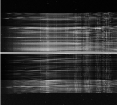
|
Hectospec
Status as of 2004-10-14
|

|
![[TDC Home]](/images/tdc-home.gif)
![[TDC Search]](/images/tdc-search.gif)
![[OIR Home]](/images/oir-home.gif)
|
[Definitions] [Preparation] [Observation] [Reduction] [Pipeline] [Distribution] [Archiving]

|
Hectospec
Status as of 2004-10-14
|

|
![[TDC Home]](/images/tdc-home.gif)
![[TDC Search]](/images/tdc-search.gif)
![[OIR Home]](/images/oir-home.gif)
|
[Definitions] [Preparation] [Observation] [Reduction] [Pipeline] [Distribution] [Archiving]
Each final spectrum can be uniquely identified by its path:
yyyymmdd.pppppp.aaawhere . can be replaced by / to recreate the path to the data.
Minicam, Megacam, Hectospec, Hectochelle, and SWIRC add the challenge that the program numbers on the observing schedule are being assigned by three different groups of people. We have decided to keep the numbers the Time Allocation Committees have assigned, which change each trimester. The assigned numbers will be propogated with the trimester and assigning institution attached:
trimester-TAC-numberwhere trimester is the 4-digit year and a letter (A, B, C), TAC is SAO, UAO, or PA (Public Access), and the number is the identifier (number for SAO, letter and number for UAO, and string for PA) assigned by the TAC.
Here is an example:
2004A-SAO-02 Bringing Hectospec to Full PerformanceThis identifier would added to all associated data files under the PROPID keyword, with the name of the associated principal investigator in the PI keyword. The title, if available, should be in PROPNAME. These keywords should be in all fiber configuration and field catalog starbase files as well as the FITS data files:
PROPID = '2004A-SAO-02' PROPNAME= 'Bringing Hectospec to Full Performance' PI = 'Fabricant' or PROPID = '2004C-UAO-S38' PI = 'Zabludoff'
The advantage of this system is that the same number will identify data for its entire lifetime, from the time the proposal is approved by the Time Allocation Committee until the reduced data resides in a VO-asccessible archive. The primary disadvantage of this system is that an observing program which lasts several trimesters will have several identifiers, unlike existing FAST spectra, but like all other data from our telescopes.
Program ID's and titles have been assigned for Hectospec, Hectochelle, and Megacam.